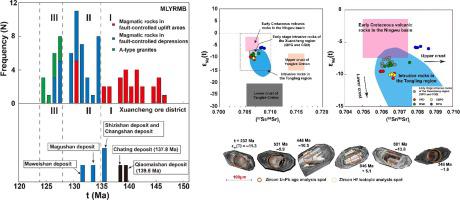当前位置:
X-MOL 学术
›
Ore Geol. Rev.
›
论文详情
Our official English website, www.x-mol.net, welcomes your
feedback! (Note: you will need to create a separate account there.)
Geochronology, petrogenesis and metallogenic implications of mineralization-related intrusive rocks in the Xuancheng ore district, Eastern China
Ore Geology Reviews ( IF 3.2 ) Pub Date : 2020-10-01 , DOI: 10.1016/j.oregeorev.2020.103690 Yue Li , Feng Yuan , Simon M. Jowitt , Yufeng Deng , Xunyu Hu , Guangxian Liu , Xiaohui Li , Taofa Zhou
Ore Geology Reviews ( IF 3.2 ) Pub Date : 2020-10-01 , DOI: 10.1016/j.oregeorev.2020.103690 Yue Li , Feng Yuan , Simon M. Jowitt , Yufeng Deng , Xunyu Hu , Guangxian Liu , Xiaohui Li , Taofa Zhou

|
Abstract The Xuancheng ore district is a newly discovered ore district within the Middle and Lower Yangtze River Metallogenic Belt (MLYRMB) of Eastern China. This district contains numerous skarn–porphyry deposits and this study focuses on four intrusions associated with known skarn mineralization within this district, namely the Shizishan pyroxene diorite (SPD), the Changshan biotite–pyroxene diorite (CBPD), the Maweishan quartz diorite (MQD), and the Magushan porphyritic granodiorite (MPG). New U–Pb zircon age data indicate that all of these intrusions formed between 136 and 132 Ma. They are all calc-alkaline, enriched in the large ion lithophile elements (LILE) and the light rare earth elements (LREE), are depleted in the high field strength elements (HFSE) and the heavy REE (HREE), and have slightly negative Eu anomalies. The SPD and CBPD have similar (87Sr/86Sr)i (0.7060–0.7068 and 0.7065–0.7068), eNd(t) (−10.6 to −9.5 and −10.1 to −9.9), and zircon eHf(t) (−16.5 to −10.3 and −13.2 to −9.9) values whereas the MQD intrusion has similar (87Sr/86Sr)i (0.7062–0.7076) values but higher eNd(t) (−8.7 to −8.2), and zircon eHf(t) values (−11.9 to −6.2) than the SPD and the CBPD. This indicates that the magmas were predominantly derived from the enriched lithospheric mantle but the MQD magmas incorporated less crust-derived material than the SPD and CBPD magmas. The MPG intrusion has different (87Sr/86Sr)i (0.7079–0.7086), eNd(t) (−6.0 to −5.7), and zircon eHf(t) values (−5.1 to −2.1) than the other intrusions, indicating this intrusion formed from magmas derived from the lithospheric mantle that assimilated upper crustal material prior to and/or during emplacement. The compositions of plagioclase within the MQD and MPG intrusions provide no evidence of magma mixing. These new data indicate that the 136–132 Ma magmatism within the Xuancheng region formed from magmas generated by the partial melting of an enriched region of the lithospheric mantle that was previously metasomatized by fluids derived from a subducted oceanic lithospheric slab. The magmas then underwent fractional crystallization (e.g., the MQD intrusion) and/or the assimilation of crustal material (e.g., the MPG intrusion). These processes generated parental magmas that were enriched in H2O, S, and metals (e.g., Cu), increasing their mineralizing potential and potentially leading to the formation of the skarn deposits within the Xuancheng ore district. Identifying intrusions with similar characteristics may be a useful exploration tool for skarn-type mineralization within this region and the wider MLYRMB.
更新日期:2020-10-01











































 京公网安备 11010802027423号
京公网安备 11010802027423号